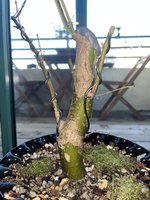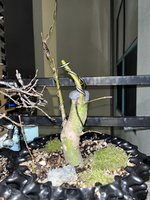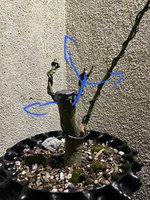A few quick takes:
All the branches appear to be on a plane. My first thought is to prune that lowest branch down to the first node that has buds (more or less) perpendicular to this plane. This appears to be the lowest node. Further, you could carefully wire the new shoots later this year so that the internodes aren't arrow straight. Btw, I find it curious that you have wire on this branch, but it isn't doing anything. I'm thinking that it is a vestige of your discovery that JM stems quickly become quite rigid and brittle --> 2 year's old and it is too late.
The branch pair at the top of the chop are pretty much what one wants so that the chop wound can be grown over. However, no one seems to care much for the competing leaders theme, so ultimately one will need to be chopped down and made into a branch while the other will be more of the trunk - just something you'll need to keep in mind. Meanwhile you just need to let it grow for a few years, carefully wiring young stems (for a month or two) so that your tree's internodes are not arrow straight.
On the other hand, you could chop it again, down to that node of your lowest branch, if your ambitions are to produce a shogun. It's the same game all over again, with the risks that you recognize, but maybe a more exciting/interesting future. Of course, the smaller the tree, the more important are shorter internodes. I've noted that the shortest internodes are naturally produced by the last flush of the season. So one strategy might be to let it grow and then prune back in Aug/Sep. Then careful fall wiring of that be growth. Rinse and repeat annually with selective pruning to produce the bones. The alternative is the conventional bonsai thing of plucking out the tips of emerging buds in spring. It stops branch extension, hence making a short internode. It also saps the vigor of the tree which is not what one wants during development. Nor is it something one can continually do with a 'finished' tree.
Lastly, internode size only matters where you need short internodes, which is primarily in the final branching. One can graft to put branches in a long internode on the trunk, for example by thread/approach grafting.
 8424C1F0-E69F-40C4-9B7A-C113530C6521.jpeg384 KB · Views: 121
8424C1F0-E69F-40C4-9B7A-C113530C6521.jpeg384 KB · Views: 121 BC88C7C2-C7A4-43D8-9AC3-A221CEEA2E3E.jpeg151.5 KB · Views: 113
BC88C7C2-C7A4-43D8-9AC3-A221CEEA2E3E.jpeg151.5 KB · Views: 113 436E3E43-DECC-4704-BDDE-B8C5857AB8E2.jpeg223.7 KB · Views: 104
436E3E43-DECC-4704-BDDE-B8C5857AB8E2.jpeg223.7 KB · Views: 104 59CE73E3-9312-4BFE-8D34-4AAF407C26FD.jpeg192.5 KB · Views: 110
59CE73E3-9312-4BFE-8D34-4AAF407C26FD.jpeg192.5 KB · Views: 110 59E82F2E-DAAF-4D22-835F-2CF0361A7BC1.jpeg194.5 KB · Views: 129
59E82F2E-DAAF-4D22-835F-2CF0361A7BC1.jpeg194.5 KB · Views: 129

